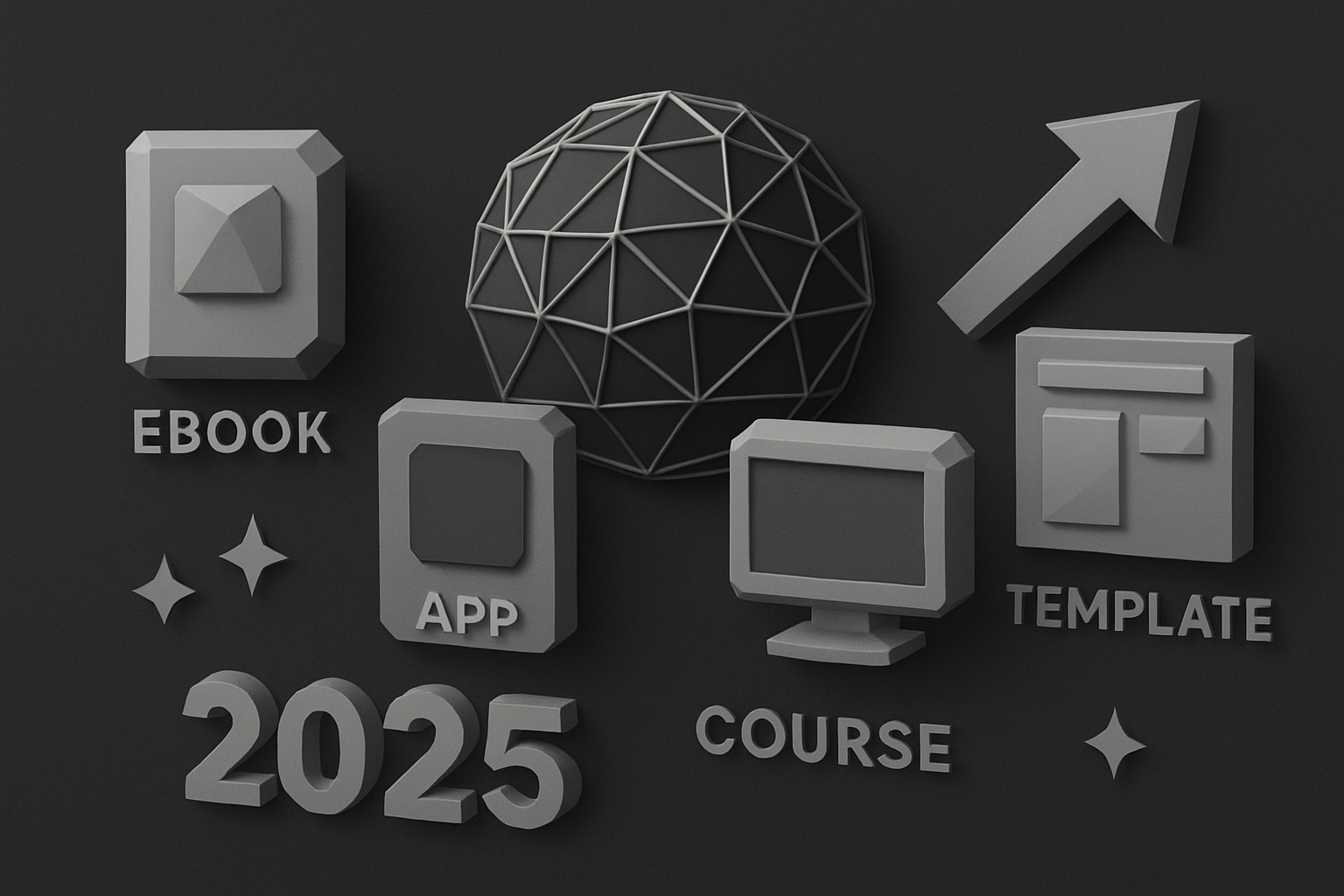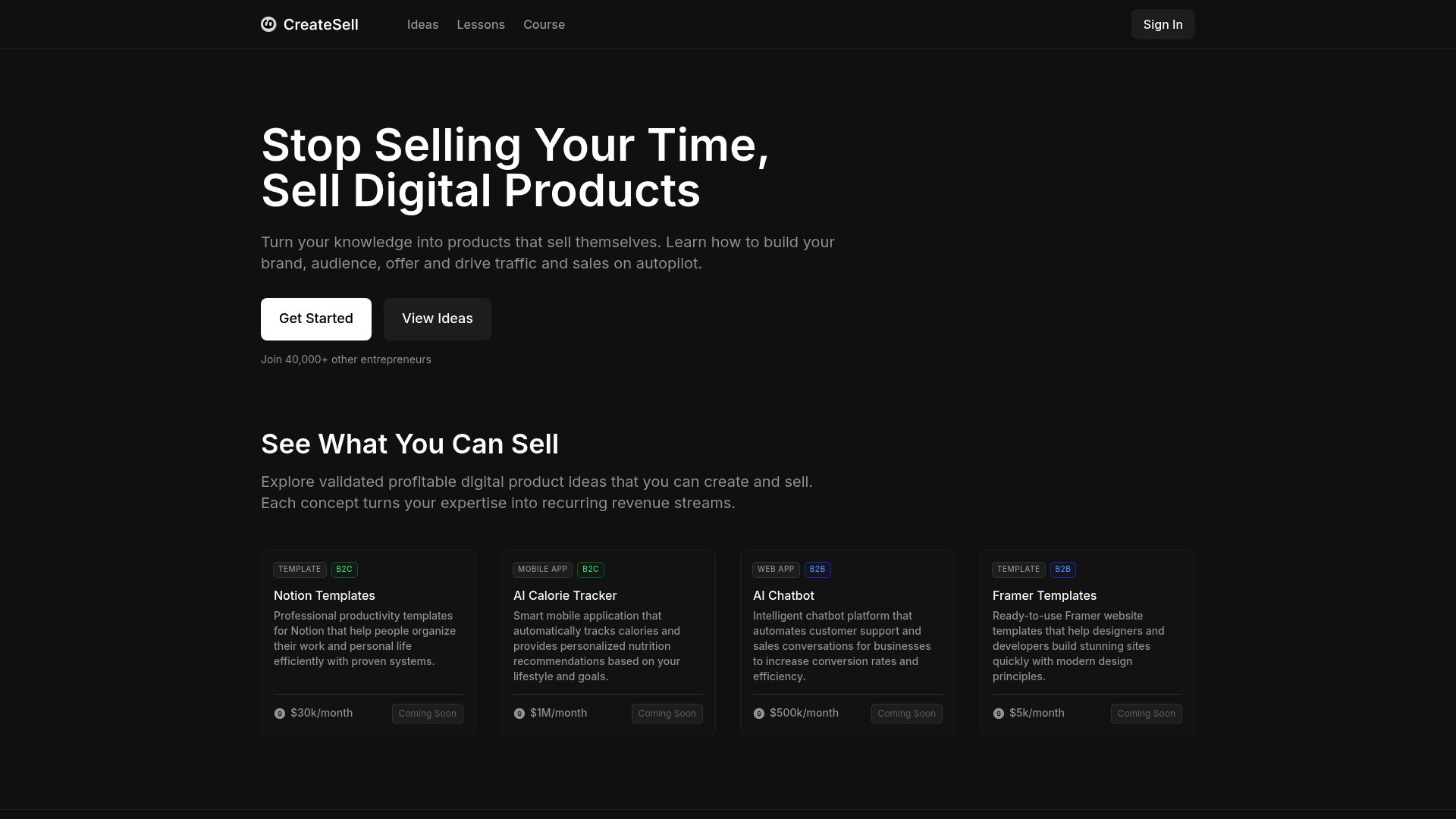In 2025, building digital products has never been more rewarding—or more competitive. The global digital product market is booming, opening new doors for creators who want to turn their knowledge into scalable income streams.
This guide equips you with proven strategies for building digital products that stand out and thrive. Whether you’re a seasoned entrepreneur or just starting out, you’ll discover how to validate ideas, craft irresistible offers, leverage the latest tools, automate sales, and future-proof your business for lasting success.
Ready to unlock your digital product potential? Let’s dive in.
Understanding the Digital Product Landscape in 2025
The world of building digital products in 2025 is both dynamic and fiercely competitive. As creators and entrepreneurs flock to this booming market, understanding what sets digital products apart—and how trends, challenges, and audiences are evolving—is essential if you want to succeed.

Defining Digital Products and Their Advantages
Digital products are intangible goods delivered electronically—think eBooks, online courses, SaaS platforms, templates, and mobile apps. The primary advantages of building digital products include scalability, minimal overhead, and instant delivery worldwide. Unlike physical products, there’s no inventory to manage or shipping delays to worry about.
Popular digital product types in 2025 include AI-powered productivity tools, niche membership sites, and customizable design templates. Notably, consumer habits have shifted toward digital-first solutions, driving explosive market growth. According to Statista, the global digital product market is projected to reach $400B+ by 2025, making building digital products a compelling opportunity for creators and businesses alike.
Trends Shaping Digital Product Success
Several key trends are shaping the success of building digital products this year. AI integration is revolutionizing personalization and automating customer journeys. Micro-products—bite-sized, hyper-niche solutions—are rising in popularity, making it easier for creators to serve targeted audiences.
Subscription models and recurring revenue streams are now the norm, while mobile-first experiences ensure users can access products anywhere, anytime. Community-driven products, such as private membership groups, foster loyalty and improve retention. Staying ahead of these trends is crucial for anyone building digital products in 2025.
Key Challenges and Opportunities
As more people focus on building digital products, competition and market saturation have intensified. Differentiation and strong branding are non-negotiable. Creators must also navigate copyright, licensing, and digital rights to protect their work.
Legal compliance aside, opportunities abound in emerging markets and non-English languages. A standout example: a creator offering a niche Notion template scaled to $30k/month by focusing on underserved audiences. Overcoming challenges in building digital products often means turning obstacles into springboards for innovation and growth.
Audience and Market Analysis
Effective building digital products starts with identifying profitable niches. Tools like Google Trends, Reddit, and Product Hunt make it easier to analyze demand and discover what audiences crave. Understanding pain points and desires is central—data shows 60% of creators cite audience feedback as their top driver for product development.
Successful market positioning means carving out a unique space and delivering clear value. By listening, researching, and adapting, you can ensure your building digital products journey leads to lasting success.
Step 1: Ideation and Validation—Finding Your Winning Digital Product Idea
Unlocking your path to success starts with one critical step: ideation and validation. In 2025, building digital products that stand out means knowing not just what you want to create, but also what your audience truly needs. Let’s break down how to move from a spark of inspiration to a validated, profitable digital product idea.
Brainstorming Profitable Ideas
Start your journey by brainstorming ideas that align with your expertise and audience needs. Use mind mapping to connect your skills to trending problems. Analyze competitors—what are they offering, and where do they fall short? Audience surveys can uncover unmet needs or frustrations.
Explore validated idea libraries, like the Digital product ideas library, for inspiration and to spot proven winners. Consider formats such as templates, micro-SaaS, or AI-powered productivity tools. Remember, building digital products is about matching your strengths to genuine market demand.
- Mind mapping for clarity
- Competitor research for gaps
- Surveys and feedback for real-world insights
Validating Demand Before You Build
Before investing time and resources, validate your concept. Pre-sales and waitlists are powerful tools to test if people will actually pay for your digital product. Launch a simple landing page and invite email signups—track conversions to measure genuine interest.
Build a Minimum Viable Product (MVP) and offer it to early adopters. Data shows that digital products with pre-launch waitlists are three times more likely to succeed. This approach minimizes risk and ensures you’re building digital products that the market wants.
- Pre-sales to confirm demand
- Waitlists for early traction
- MVPs for rapid feedback
Assessing Competition and Differentiation
Analyzing your competition is essential in building digital products that thrive. Study existing offers, dive into customer reviews, and pinpoint what users love—and what frustrates them. Identify gaps in features, pricing, or support.
Your unique selling proposition (USP) is your secret weapon. Maybe it’s a smoother onboarding process, stellar customer support, or a specialized feature. For example, some creators stand out simply by offering superior onboarding tutorials or community support. In a crowded market, differentiation is the key to building digital products that last.
- Competitor feature checklist
- Review analysis for pain points
- USP brainstorm session
Legal and Practical Considerations
Don’t overlook the legal side of building digital products. Make sure your idea isn’t infringing on copyrights or trademarks. Secure the right licenses for any third-party assets or software you use.
Choose the ideal format and platform—should your product be an eBook, a course, or a SaaS app? Look for platforms that fit your technical skill level and growth plans. Addressing these practicalities early helps you avoid costly missteps as you scale building digital products.
- Copyright and trademark basics
- Licensing essentials
- Format and platform selection
How CreateSell Empowers Digital Product Creators
CreateSell is on a mission to help you shift from trading time for money to building digital products that generate income around the clock. With access to validated ideas, time-saving templates, and automation frameworks, you can accelerate your launch and avoid common pitfalls.

The platform’s community support and expert guidance are designed to fast-track your success. Many entrepreneurs have transformed their expertise into thriving digital product businesses using CreateSell’s resources. If you’re serious about building digital products, leveraging a supportive ecosystem can make all the difference.
Step 2: Building and Designing Your Digital Product
Creating standout digital products in 2025 requires more than just a great idea—it’s about process, tools, and design thinking. Whether you’re launching an eBook, course, SaaS, or template, mastering each stage of building digital products is essential for success.
This section breaks down the journey, from outlining to automation, so you can confidently bring your vision to life.

Planning and Outlining Your Product
The foundation of building digital products is a clear structure. Start by mapping out your product’s core purpose and the transformation it delivers for users. For example, a high-converting course often follows this outline:
Module 1: Introduction & Goal Setting
Module 2: Core Concepts
Module 3: Step-by-Step Implementation
Module 4: Real-World Applications
Module 5: Wrap-Up & Next Steps
Break content into digestible, actionable pieces. Use mind maps or flowcharts to visualize the user journey. The more intentional your outline, the smoother your creation process will be.
Choosing the Right Tools and Platforms
Selecting the right platforms is pivotal for building digital products efficiently. Here’s a quick comparison for popular creation tools:
| Tool | Best For | Notable Feature |
|---|---|---|
| Notion | Templates, guides | Real-time collaboration |
| Framer | Web apps, design | Visual prototyping |
| Webflow | Websites, apps | No-code flexibility |
| Teachable | Online courses | Built-in analytics |
Consider:
- Ease of use
- Scalability
- Integrations
- Marketplace reach (Gumroad, Etsy, AppSumo)
Choose a platform that aligns with your skill level and growth plans.
Content Creation Best Practices
Great content is the heart of building digital products. Focus on clarity and actionability—every section should help users achieve a specific result.
Tips for engaging content:
- Use short paragraphs and bullet points for readability
- Incorporate video, audio, and interactive elements
- Ensure accessibility and mobile responsiveness
For a deeper dive, explore this Comprehensive digital products guide for proven frameworks and checklists.
Designing for User Experience (UX)
Exceptional UX can make or break your digital product. Prioritize intuitive navigation—users should always know what to do next. Visual branding should be consistent, reinforcing trust and recognition.
A mobile-first approach is increasingly vital. In 2025, products with streamlined mobile UX saw a 25% higher course completion rate. Use onboarding flows that welcome and orient users, reducing friction from the start.
Testing, Feedback, and Iteration
Building digital products is an iterative process. Launch a beta version to a small group and collect honest feedback. Ask questions like:
- What was confusing?
- Where did you get stuck?
- What would you improve?
Use this input to refine your product. Iteration cycles—release, test, improve—help you adapt quickly and deliver value.
Automation and Scalability Considerations
As you grow, automation becomes essential for building digital products that scale. Set up:
- Automated delivery (instant downloads, onboarding emails)
- Scalable hosting (cloud-based, reliable uptime)
- Automated support (chatbots, FAQs)
Case in point: A six-figure template business used automation to handle sales surges without missing a beat. With the right systems, you can focus on innovation, not logistics.
Step 3: Launching and Marketing Your Digital Product
The moment has arrived—your digital product is ready to meet the world. But launching isn’t just about hitting “publish.” In 2025, building digital products that actually sell requires a strategic plan, magnetic messaging, and smart marketing. Let’s break down the exact steps you need to launch with confidence and maximize your sales potential.

Crafting a Compelling Offer and Messaging
To stand out in a crowded market, your offer needs to solve a specific problem for your audience. Start by identifying the core pain point your digital product addresses. Next, create irresistible bundles, bonuses, or time-limited deals—these strategies can significantly increase perceived value.
Conversion rates are often higher for bundled offers compared to single products. Consider this quick comparison:
| Offer Type | Avg. Conversion Rate |
|---|---|
| Single Product | 2.5% |
| Bundled Offer | 4.1% |
For a step-by-step approach to building digital products and crafting offers that convert, check out this Step-by-step digital products checklist. It’s your roadmap to launch success.
Building Your Pre-Launch Audience
A successful launch begins long before your product goes live. Start building digital products buzz early by growing an email list. Offer a free lead magnet—like a sample chapter or mini-course—to attract subscribers. Collect testimonials and social proof from beta testers or early adopters.
Engage your audience in relevant communities such as Discord servers, Slack groups, or Facebook Groups. The more invested your audience feels before launch, the more likely they are to support your digital product when it drops.
Launch Strategies That Work in 2025
Choosing the right launch strategy is crucial for building digital products that thrive. Live launches can generate excitement and urgency, while evergreen launches allow for continuous sales without the pressure. Platforms like Product Hunt remain effective for generating buzz and early traction.
Don’t overlook influencer and affiliate partnerships—these can rapidly expand your reach. Collaborate with creators whose audiences align with your niche for maximum impact.
Content Marketing and SEO for Digital Products
Content marketing remains a cornerstone for building digital products that get noticed. Start a blog, guest post on relevant sites, or appear on podcasts to share your expertise. Optimize your digital product landing pages for SEO by including target keywords and answering user intent.
For example, one creator grew sales by 40% simply through consistent SEO-driven blog content and optimized product pages. Strategic content can drive organic traffic long after your initial launch, compounding your results over time.
Paid Advertising and Retargeting
Paid ads are a powerful way to accelerate your launch. Platforms like Facebook, Instagram, and TikTok offer robust targeting for building digital products audiences. Retargeting ads help recover abandoned carts by reminding potential buyers of your offer.
Average Return on Ad Spend (ROAS) for digital product ads in 2025 is 3.2x, but results improve with compelling creatives and precise targeting. Test small budgets, analyze results, and scale what’s working to maximize your ad spend.
Measuring Launch Success and Optimizing
After your launch, it’s time to analyze what worked—and what didn’t. Track key metrics, including:
- Sales volume
- Conversion rates
- Customer acquisition cost
- Traffic sources
Use analytics tools to identify trends and optimize your approach. Iterating your offer based on real data is essential for building digital products that grow and remain profitable. Continuous improvement leads to higher lifetime value and long-term success.
Step 4: Automating Sales and Scaling Your Digital Product Business
Scaling up and automating sales is where building digital products truly shines. Once your product is live, the next goal is to put systems in place that maximize revenue while minimizing manual effort. Let’s break down exactly how to automate, expand, and future-proof your digital product empire—step by step.
Setting Up Automated Sales Funnels
The backbone of building digital products at scale is a well-oiled automated sales funnel. Start by mapping out your customer journey—from initial awareness to purchase and beyond. Use email marketing sequences to nurture leads, introduce upsells, and offer cross-sells or order bumps at just the right moment.
A simple funnel might look like:
- Lead magnet (free download) → Welcome email series
- Product pitch with limited-time bonus
- Automated follow-up for non-buyers
- Upsell offer post-purchase
Automating these steps means you’re always selling, even while you sleep. For inspiration on sustainable automation, check out Create once, sell forever strategies.
Leveraging Marketplaces and Distribution Channels
Expanding your reach is essential when building digital products. Don’t rely on a single platform—list your product on popular marketplaces like Gumroad, Etsy, and Udemy, as well as niche platforms suited to your content. Each channel has its pros and cons regarding fees, audience, and control.
Here’s a quick comparison:
| Platform | Audience Size | Fees | Customization |
|---|---|---|---|
| Gumroad | Medium | Low | High |
| Etsy | Large | Medium | Moderate |
| Udemy | Huge | High | Low |
A multi-channel presence helps you tap into new customer bases and diversify revenue streams, a must for anyone serious about building digital products.
Building a Brand and Community Around Your Product
In 2025, building digital products is not just about the product—it’s about the brand and the tribe. Establish a personal brand to foster trust and credibility. Engage your audience through communities on Discord, Slack, or private Facebook Groups.
Benefits of building a community include:
- Higher retention rates
- Ongoing feedback and testimonials
- Built-in audience for future launches
Products with active communities see double the retention rate, making community-building a smart move for long-term success.
Customer Support and Experience Automation
Exceptional customer support can set your digital product apart. Automate onboarding with email sequences and set up AI-powered chatbots to answer common questions 24/7. An automated FAQ page can resolve issues quickly, reducing the support burden.
For example, one creator implemented a chatbot and saw support tickets drop by 50%. When building digital products, streamlined support ensures happy customers and frees up your time to focus on innovation.
Scaling with Partnerships and Affiliates
To truly scale, tap into the power of partnerships and affiliate programs. Recruit affiliates who can promote your product to their audiences in exchange for a commission. Partner with complementary brands or influencers for co-marketing opportunities.
Affiliate-driven sales now account for over 25% of revenue in top digital product businesses. Building digital products with a partner network in mind multiplies your reach and revenue potential exponentially.
Maintaining and Updating Your Product
The digital landscape evolves quickly, so regular updates are crucial for staying competitive. Gather feedback from your community, monitor analytics, and roll out improvements or new features each month.
Monthly updates have been shown to increase customer lifetime value by 40%. Building digital products is an ongoing process—maintaining relevance ensures your business thrives for years to come.
Future-Proofing Your Digital Product Business
The digital marketplace never stands still. As you focus on building digital products, future-proofing your business ensures you adapt, thrive, and stay ahead—no matter how the landscape shifts. Let’s break down the must-have strategies to secure your long-term success and resilience.
Adapting to Emerging Technologies
Staying competitive in building digital products means embracing cutting-edge tech. In 2025, AI, AR/VR, and automation tools are transforming everything from customer support to content creation. For example, Apple’s move to open its AI models to developers is accelerating innovation and enabling creators to personalize their offerings like never before—see AI integration in digital products 2025 for a glimpse into this trend.
Early adoption of tools like AI-generated content or immersive platforms can help your digital products stand out. Evaluate new tech regularly and test what works best for your audience.
Navigating Legal and Regulatory Changes
Building digital products at scale requires staying compliant with ever-shifting laws. Regulations such as GDPR, copyright, and evolving digital taxation rules impact how you collect data, deliver content, and manage customer privacy.
Invest in tools that automate compliance checks and monitor regulatory updates. Consider consulting a legal expert if you plan to expand globally. Staying proactive protects your business from costly legal pitfalls and builds trust with your customers.
Building Multiple Revenue Streams
Diversifying your income is essential for long-term stability when building digital products. Top creators expand beyond a single offer, adding new products and upsells to maximize their earning potential.
Popular revenue streams:
- Courses and memberships
- Premium support or consulting add-ons
- Licensing your content to other businesses
- B2B sales and enterprise packages
A varied portfolio not only boosts profits but also minimizes risk if one product’s demand dips.
Protecting Your Intellectual Property
With the rise in digital piracy, safeguarding your assets is critical for anyone building digital products. Strategies include watermarking files, using licensing agreements, and monitoring for unauthorized sharing.
Did you know that in 2024, 20% of digital creators reported IP theft? Embedding unique identifiers and securing your files help deter bad actors. Staying vigilant ensures your hard work remains protected and your reputation stays intact.
Measuring Long-Term Success
Tracking the right metrics is vital for sustainable growth in building digital products. Focus on Key Performance Indicators (KPIs) that reveal your business’s health and highlight areas for improvement.
| KPI | Why It Matters |
|---|---|
| Retention Rate | Indicates product stickiness |
| Lifetime Value | Measures long-term profitability |
| Churn Rate | Identifies customer loss trends |
Regularly review these numbers and set fresh goals each quarter to keep momentum strong.
Staying Connected with Your Audience
Lasting success in building digital products comes from nurturing your relationship with customers. Use email updates, exclusive community spaces, and interactive content to keep your audience engaged.
Actively seek feedback—it’s a goldmine for future product ideas and improvements. In fact, 70% of top creators say audience relationships drive their growth. By putting your community first, you create a loyal base ready to support your next big launch.
If you’re feeling inspired to turn your expertise into a thriving digital product business, you’re in the right place. We’ve covered everything from idea validation to scaling up, but taking the first step is what makes all the difference. Whether you have a solid idea or just a spark, it’s never been easier—or more rewarding—to start building for 2025’s digital landscape. Let’s put your knowledge to work and create something that truly lasts. Ready to make your move? Get Started and see how you can build, launch, and grow with confidence.